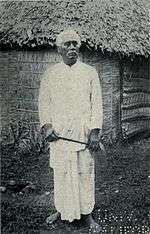Mata'afa
Mata'afa is one of the four paramount tama-a-'aiga (maximal lineage) titles of Samoa.[1] [2] It is one of two such titles originating from the Atua district at the east end of Upolu island (the other being Tupua Tamasese of Falefa & Salani) and has its historical seat of the Mata'afa title is in Amaile.[3] Prominent holders of the title included Mata'afa Faumuina Fiame Mulinu'u I (died 1948), a leader of Samoa's pro-independence Mau movement and Fiame Mata'afa Faumuina Mulinu'u II (1921–1975), the first Prime Minister of Samoa.

The title was vacant from 1997 (with the death of Mata'afa Fa'asuamaleaui Pu'ela Patu) to May 2011, when it was bestowed upon Mata'afa Tupuola Lui, "an 83 year old village chief of Amaile village".[4] After his death in 2014, the title again fell vacant.[5]
Origins of the Matā'afa
The beginnings of the tama-a-'aiga Matā'afa lineage is traced through to Queen Salamasina and branches off with title's lineal ancestor Luafalemana, the son of King Tupua Fuiavailili and Punipuao, daughter of Alai'asā of Falefa.[6] Luafalemana married Gese and together had a daughter, Salaina'oloa. Having been issued and raised by 'Aiga Sā Fenunuivao (descendants of Fenunuivao) of which both Alai'asā and Luafalemana are a part of, she married Tuimavave (also known as Tauili'ili) of 'Aiga Sā Levālasi (descendants of Levalasi). Their union issued the first line of the Matā'afa titleholders, Fa'asuamale'aui, in 1785.[1] Tuimavave's other union with Letelesā issued another line of the title, Silupevailei. Both Fa'asuamale'aui and Silupevailei are the two lines of descent from whom the Mata'afa is selected.
Tuimavave's union with King Tupua's grand-daughter, Salaina'oloa, has resulted in the Matā'afa titles' close association with the other tama-a-aiga title, Tupua Tamasese. This has at times, resulted in Matā'afa holders also holding Tupua title concurrently, like Matā'afa Iosefo, who became known as Tupua Matā'afa Iosefo.[6] By joining the daughter of Luafalemana with Tuimavave, the Tui Atua line arrives at a harmonious junction between the two great tama-a-'aiga families of Samoa - 'Aiga Sā Levālasi (custodian of the Matā'afa title) and 'Aiga Sā Fenunuivao (custodian of the Tupua Tamasese title).[1]
Family traditions differ as to who was the first Mata'afa, but the majority of opinions favour either Filifilisounu'u, son of Fa'asuamale'aui or Tafagamanu, son of Filifilisounu'u.[1] Either way, it is the line of Fa'asuamale'aui that began and carried the title from its inception to 1948, when Silupevailei's line took over. After subsequent appeals before the Lands & Titles Court, the title returned to Fa'asuamale'aui's line upon the death of Prime Minister Fiame Mata'afa Faumuina Mulinu'u II, where it was bestowed on Mata'afa Puela Faasuamaleaui Patu who held it until his passing in 1997. The title remains vacant to this day.[1]
Title holders
Holders of the Mata'afa title include;
- Mata'afa Iosefo (1832–1912), a rival for the 'kingship' of Samoa during the country's colonial era.
- Mata'afa Tupuola Iose (1912–1915)
- Mata'afa Muliufi (1915–1936), a member of the Legislative Council
- Mata'afa Faumuina Fiame Mulinu'u I (died 1948), a leader of Samoa's pro-independence Mau movement.
- Was married to a daughter of the other tama-a-'aiga, Malietoa Laupepa.
- Fiame Mata'afa Faumuina Mulinu'u II (1921–1975), son of Mata'afa Faumuina Fiame Mulinu'u I. First Prime Minister of Samoa.
- Was married to Laulu Fetauimalemau Mata'afa (1928–2007).
- Their daughter Hon. Fiame Naomi Mata'afa, is the current high chief of Lotofaga and the Deputy Prime Minister of Samoa.
Title was then bestowed upon Mata'afa Puela Faasuamaleaui Patu until 1997 when he passed away.
Gallery
 Mata'afa Iosefo (1832 - 1912)
Mata'afa Iosefo (1832 - 1912) Fiame Naomi Mata'afa (standing, far left) at a meeting of Pacific Islands leaders with US Secretary of State Condoleezza Rice (center), in Samoa, 26 July 2008
Fiame Naomi Mata'afa (standing, far left) at a meeting of Pacific Islands leaders with US Secretary of State Condoleezza Rice (center), in Samoa, 26 July 2008
See also
| Wikimedia Commons has media related to Mata'afa. |
- Fa'amatai, chieflty system of Samoa.
- Muagututi'a
- Malietoa
- Tuimaleali'ifano
- Tupua Tamasese
- Tui Manu'a
- German Samoa
- History of Samoa
- Politics of Samoa
References
- Tuimaleali'ifano, Morgan A. (19XX). (2006). O tama a 'aiga he politics of succession to Samoa's paramount titles. Institute of Pacific Studies, University of the South Pacific. ISBN 978-982-02-0377-8. OCLC 494614506.
- Tradition versus democracy in the South Pacific: Fiji, Tonga, and Western Samoa by Stephanie Lawson, p. 146
- Meleisea, Malama (1987). The Making of Modern Samoa. University of the South Pacific. p. 54. ISBN 982-02-0031-8. Retrieved 8 March 2010.
- "Mata'afa paramount title in Samoa bestowed on 83 year old village chief". Radio New Zealand International. 29 May 2011. Retrieved 22 October 2011.
- "Tui Atua Mata'afa Tupuola Lui Iosefo R.I.P". 4 November 2014. Retrieved 22 March 2017.
- Krämer, Augustin, 1865-1941. (1999) [1994]. The Samoa Islands : an outline of a monograph with particular consideration of German Samoa. University of Hawaii Press. ISBN 0-8248-2219-6. OCLC 58450475.CS1 maint: multiple names: authors list (link)